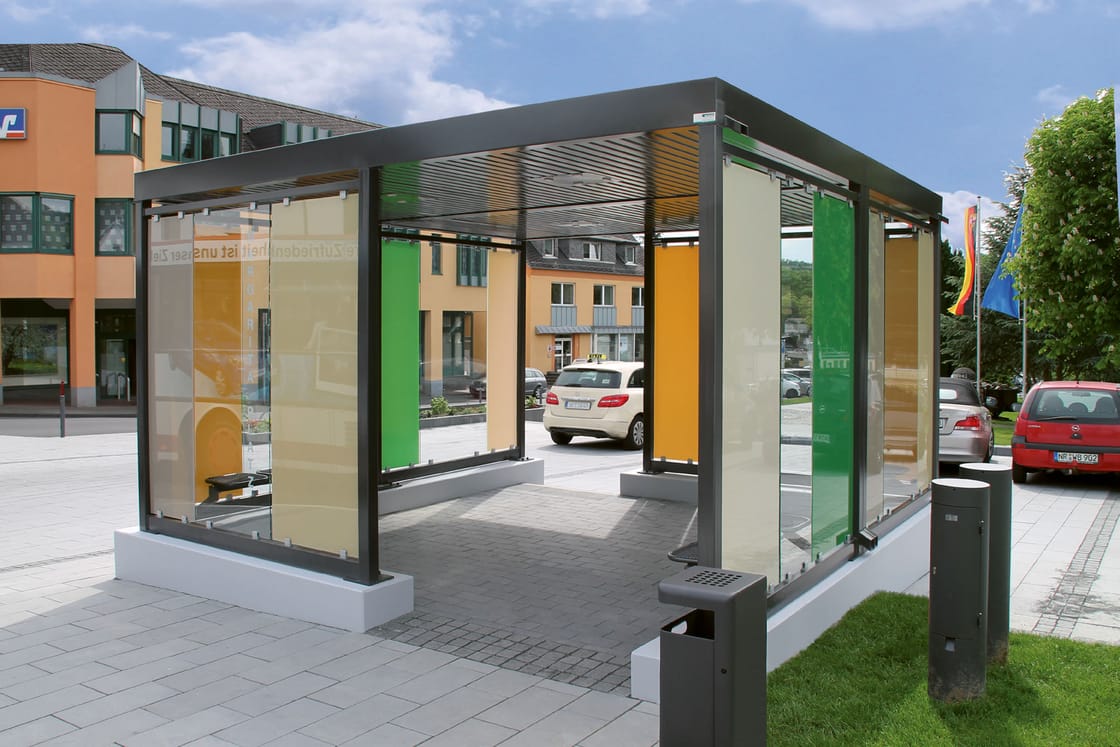Protect what is dear and valuable to us
Building a house is in the nature of man – that’s how a building society advertised products a few years ago that were supposed to help its customers achieve their “own four walls”. And indeed, there is probably no human civilization that does not know structures for protection from rain, snow, cold winds, or even burning sunshine – roofing.
In the industrialized nations of our day, the uses of canopies are exceedingly varied, ranging from shelters for storage yards, carports and canopies for bicycle parking facilities to weather-protected smoking shelters and comfortable bus stop shelters, entrance canopies or pavilions for entertainment and information.
In addition to their actual protective function, such canopies, shelters and bus shelters also have aesthetic functions, for example by complementing architectural concepts through their shape and color scheme or by enhancing unused areas and putting them to new uses. As weatherproof meeting places that provide safety and comfort, they also fulfill important social functions.
Economical modular construction
Roofing protects what is dear and valuable to us, and at the same time can be erected quickly and with little effort. First of all, the question of space must be clarified: How large is the available installation area, and how high may the structure be? Does the substrate support? Where to put melt water and rainwater? How wide do the entrances have to be? Questions that are mostly unproblematic, so that standardized and proven modular systems can be used that are quickly delivered and safely installed.
More costly custom-made products are not necessary for many purposes. Here, too, a wide range of design options gives scope for individual wishes and enables adaptation to architectural or corporate design concepts. High-quality materials and careful workmanship ensure that canopies defy even the adverse environmental conditions from which they protect people and materials, and provide many years of service. Although overall maintenance costs are very low, canopies should also be professionally maintained and cleaned, and damaged components replaced promptly.
What goes where
Among the more challenging issues is the choice of the place of installation, because not everything that is a roofing may be placed everywhere. Depending on the installation site and the planned use, legal regulations must often also be complied with.
If storage areas may not be erected everywhere, for example for reasons of occupational safety or environmental protection, this naturally also applies to storage area roofing or smoking shelters. Smokers’ shelters increase acceptance and implementation of safety and non-smoker protection regulations and must be installed with safety considerations in mind.
Home and apartment owners also have a few things to keep in mind. State building codes now make the installation of covered bicycle parking mandatory. Those who erect a roof privately, either to protect waste garbage cans, equipment or even bicycles, should also pay attention to the legitimate interests of their neighbors or perhaps consider a larger communal installation right away.
For structures accessible to the public, such as passenger shelters for buses and streetcars, proof of stability must be provided. Uniform type statics, which can be created in advance and as an example for roofs, ensure that roofs can withstand maximum wind and snow loads and thus save time-consuming individual tests. When installing such bus shelters or passenger shelters, additional structural criteria must also be met.
Safety and comfort
Building canopies is probably in the nature of man. However, contemporary roofing solutions offer much more than just the proverbial roof over your head, perhaps supplemented by side panels to protect against wind and rain.
Benches and litter garbage cans but also sophisticated lighting systems also provide comfort and make you feel safe. Shape and color design and almost unlimited glass printing options make the experience even more pleasant and offer planners and architects interesting design options – for example, as part of city marketing concepts.
In addition to active illumination by energy-saving LEDs, film-coated lenses and reflective films provide passive safety, for example by reflecting warning symbols when headlights hit them. And if something does break: single-pane safety glass (ESG) protects against unnecessary injuries caused by glass splinters.
Consulting pays off
Canopies are relatively uncomplicated structures, but still worth professional advice from the manufacturer. Whether it is a question of stability, design variants or building regulations to be observed – manufacturers have the necessary know-how and can thus save time and costs, especially in more complex projects.
Certified manufacturing processes ensure the highest possible quality of materials, workmanship and finish. Type statics make time-consuming expert opinions unnecessary, and 3D modeling processes enable “viewing” of the planned roofing solution, often including all design-relevant parameters and objects. Thus, nothing is left to chance, and nothing stands in the way of the fast and economical realization of the desired roofing solution.
